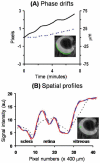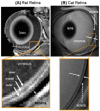Magnetic resonance imaging of the retina
- PMID: 19763752
- PMCID: PMC2901235
- DOI: 10.1007/s10384-009-0688-1
Magnetic resonance imaging of the retina
Abstract
This paper reviews recent developments in high-resolution magnetic resonance imaging (MRI) and its application to image anatomy, physiology, and function in the retina of animals. It describes technical issues and solutions in performing retinal MRI, anatomical MRI, blood oxygenation level-dependent functional MRI (fMRI), and blood-flow MRI both of normal retinas and of retinal degeneration. MRI offers unique advantages over existing retinal imaging techniques, including the ability to image multiple layers without depth limitation and to provide multiple clinically relevant data in a single setting. Retinal MRI has the potential to complement existing retinal imaging techniques.
Figures













Similar articles
-
Layer-specific anatomical, physiological and functional MRI of the retina.NMR Biomed. 2008 Nov;21(9):978-96. doi: 10.1002/nbm.1311. NMR Biomed. 2008. PMID: 18792422 Free PMC article. Review.
-
Anatomical, blood oxygenation level-dependent, and blood flow MRI of nonhuman primate (baboon) retina.Magn Reson Med. 2011 Aug;66(2):546-54. doi: 10.1002/mrm.22853. Epub 2011 Feb 28. Magn Reson Med. 2011. PMID: 21360746 Free PMC article.
-
MRI reveals differential regulation of retinal and choroidal blood volumes in rat retina.Neuroimage. 2011 Jan 15;54(2):1063-9. doi: 10.1016/j.neuroimage.2010.09.020. Epub 2010 Sep 17. Neuroimage. 2011. PMID: 20850550 Free PMC article.
-
Functional imaging using the retinal function imager: direct imaging of blood velocity, achieving fluorescein angiography-like images without any contrast agent, qualitative oximetry, and functional metabolic signals.Jpn J Ophthalmol. 2009 Jul;53(4):345-51. doi: 10.1007/s10384-009-0689-0. Epub 2009 Sep 8. Jpn J Ophthalmol. 2009. PMID: 19763751 Review.
-
Blood-flow magnetic resonance imaging of the retina.Neuroimage. 2008 Feb 15;39(4):1744-51. doi: 10.1016/j.neuroimage.2007.10.030. Epub 2007 Nov 1. Neuroimage. 2008. PMID: 18063388 Free PMC article.
Cited by
-
Decreased retinal-choroidal blood flow in retinitis pigmentosa as measured by MRI.Doc Ophthalmol. 2013 Jun;126(3):187-97. doi: 10.1007/s10633-013-9374-1. Epub 2013 Feb 14. Doc Ophthalmol. 2013. PMID: 23408312 Free PMC article.
-
MRI of retinal and choroidal blood flow with laminar resolution.NMR Biomed. 2011 Feb;24(2):216-23. doi: 10.1002/nbm.1576. Epub 2010 Sep 6. NMR Biomed. 2011. PMID: 20821409 Free PMC article.
-
Layer-specific functional and anatomical MRI of the retina with passband balanced SSFP.Magn Reson Med. 2011 Nov;66(5):1416-21. doi: 10.1002/mrm.22935. Epub 2011 May 20. Magn Reson Med. 2011. PMID: 21604296 Free PMC article.
-
Magnetic resonance imaging of the retina: from mice to men.Magn Reson Med. 2014 Apr;71(4):1526-30. doi: 10.1002/mrm.24797. Epub 2013 May 28. Magn Reson Med. 2014. PMID: 23716429 Free PMC article. Review.
-
Choroidal blood flow decreases with age: an MRI study.Curr Eye Res. 2014 Oct;39(10):1059-67. doi: 10.3109/02713683.2014.892997. Epub 2014 Mar 21. Curr Eye Res. 2014. PMID: 24655028 Free PMC article.
References
-
- Kaufman PL, Alm A, editors. Adler’s physiology of the eye. Mosby; St Louis: 1992.
-
- Bron AJ, Tripathi RC, Tripathi BJ. Wolff’s anatomy of the eye and orbit. Chapman & Hall Medical; London: 1997.
-
- Buttery RG, Hinrichsen CFL, Weller WL, Haight JR. How thick should a retina be? A comparative study of mammalian species with and without intraretinal vasculature. Vis Res. 1991;31:169–187. - PubMed
-
- Harris A, Kagemann L, Cioffi GA. Assessment of human ocular hemodynamics. Surv Ophthalmol. 1998;42:509–533. - PubMed
-
- Bill A. Circulation in the eye. In: Renkin EM, Michel CC, editors. Handbook of physiology, part 2, in microcirculation. American Physiological Society; Bethesda, MD: 1984. pp. 1001–1035.
Publication types
MeSH terms
Substances
Grants and funding
LinkOut - more resources
Full Text Sources
Medical

